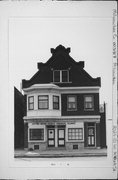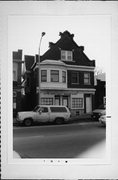| Additional Information: | "The ethnic architecture of the Szymarek Grocery Store is a reminder of the days when Milwaukee's Poles referred to Mitchell Street as the "Polish Highway" because it was the main commercial thoroughfare through the city's largest Polish neighborhood. The Eastern European Renaissance style building features what is perhaps one of the most unusual shaped gables to be found among Milwaukee's rich stock of ethnic commercial structures. The bold, sheet metal coping that outlines the gable features large projecting, pointed "cusps." The resulting profile is an interesting variation on the more typical European stepped gable, and is believed to reflect architectural traditions that have their roots in the early Renaissance buildings of Poland's largest cities such as Krakow, Posnan, and Warsaw. The Szymarek building is a good example of how a prominent architectural feature, such as a shaped gable, can imbue an otherwise ordinary building with ethnic character.
Constructed in 1915, the Polish ethnic character of the building reflects the nostalgia and pride that Polish-American immigrants felt for their former homeland. Also reflecting an old European building tradition are the one-foot-thick, solid brick, load bearing walls. Most of Milwaukee's small commercial buildings, by comparison, are of less substantial wood frame construction that is "veneered" with an outer skin of one layer of brick that is not structural, but merely a decorative finish material. It was not unusual for Milwaukee's European-born businessmen to prefer the permanence and fire resistance of a solid masonry structure because they often intended to keep their business at one location for a long period of time. They were, in effect, building for the ages.
Before moving both his residence and grocery business to this building in 1915, Szymarek operated a combined grocery store and tavern nearby at 2037-39 W. Mitchell St. After Szymarek moved, a relative kept the tavern, known as a "Polish public house," operating at its original location. This block was a neighborhood commercial strip that developed in the shadow of the large St. Vincent de Paul Roman Catholic Church on the northwest corner of S. 17th and W. Mitchell Streets. Szymarek and his family were members of the church, which was originally a polish-speaking parish, and following Polish tradition he and other merchants built their stores near the church to form a little village commercial center for their neighborhood.
Szymarek died on March 15, 1935 at the age of 60 and his wife, Stephania, ran the store after his passing for another year. By 1941 the store was rented to a beauty shop. In 1947 Dr. Joseph Szymarek, a physician, remodeled the first floor for use as his medical office. The building is still a physician's office today." MILWAUKEE ETHNIC COMMERCIAL AND PUBLIC BUILDINGS TOUR, CITY OF MILWAUKEE DEPARTMENT OF CITY DEVELOPMENT, SEPTEMBER 1994. |
|---|



